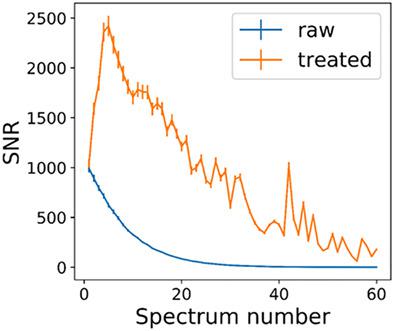当前位置:
X-MOL 学术
›
NMR Biomed.
›
论文详情
Our official English website, www.x-mol.net, welcomes your
feedback! (Note: you will need to create a separate account there.)
Application of low‐rank approximation using truncated singular value decomposition for noise reduction in hyperpolarized 13C NMR spectroscopy
NMR in Biomedicine ( IF 2.7 ) Pub Date : 2020-03-03 , DOI: 10.1002/nbm.4285 R Francischello 1, 2 , M Geppi 1 , A Flori 3 , E M Vasini 4 , S Sykora 4 , L Menichetti 2
NMR in Biomedicine ( IF 2.7 ) Pub Date : 2020-03-03 , DOI: 10.1002/nbm.4285 R Francischello 1, 2 , M Geppi 1 , A Flori 3 , E M Vasini 4 , S Sykora 4 , L Menichetti 2
Affiliation

|
Dissolution dynamic nuclear polarization allows in vivo studies of metabolic flux using 13C‐hyperpolarized tracers by enhancing signal intensity by up to four orders of magnitude. The T1 for in vivo applications is typically in the range of 10–50 s for the different 13C‐enriched metabolic substrates; the exponential loss of polarization due to various relaxation mechanisms leads to a strong reduction of the signal‐to‐noise ratio (SNR). A common solution to the problem of low SNR is the accumulation/averaging of consecutive spectra. However, some limitations related to long delays between consecutive scans occur: in particular, following biochemical kinetics and estimate apparent enzymatic constants becomes time critical when measurement scans are repeated with the typical delay of about 3 T1. Here we propose a method to dramatically reduce the noise, and therefore also the acquisition times, by computing, via truncated singular value decomposition, a low‐rank approximation to the individual complex time‐domain signals. Moreover, this approach has the additional advantage that the phase correction can be applied to the spectra already denoised, thus greatly reducing phase correction errors. We have tested the method on (1) simulated data; (2) performing dissolution of hyperpolarized 1‐13C‐pyruvate in standard conditions and (3) in vivo data sets, using a porcine model injected with hyperpolarized Na‐1‐13C‐acetate. It was shown that the presented method reduces the noise level in all the experimental data sets, allowing the retrieval of signals from highly noisy data without any prior phase correction pre‐processing. The effects of the proposed approach on the quantification of metabolic kinetics parameters have to be shown by full quantification studies.
中文翻译:

使用截断奇异值分解的低秩近似在超极化 13C NMR 光谱中的降噪应用
溶解动态核极化允许使用13 C 超极化示踪剂通过将信号强度提高多达四个数量级来进行代谢通量的体内研究。对于不同的13 ,体内应用的T 1通常在 10-50 s 范围内富含 C 的代谢底物;由于各种弛豫机制导致的偏振指数损失导致信噪比 (SNR) 大幅降低。低 SNR 问题的常见解决方案是连续光谱的累积/平均。然而,与连续扫描之间的长时间延迟相关的一些限制会出现:特别是,当以大约 3 T 1的典型延迟重复测量扫描时,遵循生化动力学和估计表观酶常数变得至关重要. 在这里,我们提出了一种方法,通过截断奇异值分解计算对单个复杂时域信号的低秩近似,从而显着降低噪声,从而降低采集时间。此外,这种方法还有一个额外的优势,即相位校正可以应用于已经去噪的光谱,从而大大降低了相位校正误差。我们已经在 (1) 模拟数据上测试了该方法;(2) 在标准条件下进行超极化 1-13 C-丙酮酸盐的溶解和(3) 体内数据集,使用注射超极化 Na-1-13 的猪模型C-醋酸盐。结果表明,所提出的方法降低了所有实验数据集中的噪声水平,允许从高噪声数据中检索信号,而无需任何事先的相位校正预处理。所提出的方法对代谢动力学参数量化的影响必须通过全面的量化研究来证明。
更新日期:2020-03-03
中文翻译:

使用截断奇异值分解的低秩近似在超极化 13C NMR 光谱中的降噪应用
溶解动态核极化允许使用13 C 超极化示踪剂通过将信号强度提高多达四个数量级来进行代谢通量的体内研究。对于不同的13 ,体内应用的T 1通常在 10-50 s 范围内富含 C 的代谢底物;由于各种弛豫机制导致的偏振指数损失导致信噪比 (SNR) 大幅降低。低 SNR 问题的常见解决方案是连续光谱的累积/平均。然而,与连续扫描之间的长时间延迟相关的一些限制会出现:特别是,当以大约 3 T 1的典型延迟重复测量扫描时,遵循生化动力学和估计表观酶常数变得至关重要. 在这里,我们提出了一种方法,通过截断奇异值分解计算对单个复杂时域信号的低秩近似,从而显着降低噪声,从而降低采集时间。此外,这种方法还有一个额外的优势,即相位校正可以应用于已经去噪的光谱,从而大大降低了相位校正误差。我们已经在 (1) 模拟数据上测试了该方法;(2) 在标准条件下进行超极化 1-13 C-丙酮酸盐的溶解和(3) 体内数据集,使用注射超极化 Na-1-13 的猪模型C-醋酸盐。结果表明,所提出的方法降低了所有实验数据集中的噪声水平,允许从高噪声数据中检索信号,而无需任何事先的相位校正预处理。所提出的方法对代谢动力学参数量化的影响必须通过全面的量化研究来证明。











































 京公网安备 11010802027423号
京公网安备 11010802027423号